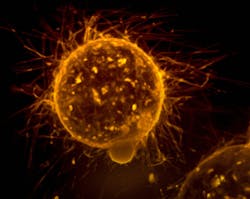Moffitt Cancer Center researchers have revealed that the creation of an immunosuppressive environment is key to the progression of benign colorectal adenomas to invasive, malignant carcinomas, according to a news release.
Their findings were published in Nature Communications.
Interactions between cells of the immune system and pre-cancerous cells are known to be important contributing factors to the initiation and progression of cancer. However, the dynamics of these interactions have not been widely understood until now.
Colorectal cancer is the third most common cancer in the U.S. Approximately 1 in 25 people will be diagnosed with it in their lifetime. Despite the high number of Americans who will develop colorectal cancer, the incidence has been decreasing due to better screening and diagnostics that can detect pre-cancerous adenomas before they develop into malignant carcinomas. Studies suggest that despite the increased risk of developing colorectal cancer in patients who have adenomas, most pre-cancerous lesions do not actually progress to a completely malignant state.
“Bowel cancer screening programs detect approximately five high risk adenomas for every cancer found and longitudinal endoscopic surveillance of adenomas reveals that less than 2% of adenomas progress to cancer within three years. Consequently, there appears to be a substantial ‘evolutionary hurdle’ that must be overcome for an adenoma to become invasive,” said lead study author Sandy Anderson, MD, Chair of the Integrated Mathematical Oncology Department and co-founder of the Center of Excellence for Evolutionary Therapy at Moffitt.
To perform a spatial ecological analysis the team developed a new tool called VALIS that aligns histology slides, making it possible to construct highly multiplexed images from tissues stained via immunohistochemistry (IHC) and/or immunofluorescence. This image shows one of the 11-plex IHC used in the spatial analysis, which revealed that progressed adenomas reside in an immunosuppressive niche.
Anderson and his team, including collaborators from Barts Cancer Institute in the UK, wanted to improve their understanding of the hurdles that pre-cancerous adenomas must overcome to progress to invasive carcinomas. They used mathematical modeling and spatial ecological analyses of patient tissues to characterize these events. Mathematical models are often used by ecologists to study interactions among different species and are ideal tools to analyze complex interactions between human cells that would otherwise be difficult to assess in typical laboratory studies with cell and mouse models.
The researchers focused their analysis on interactions between immune cells and cancer cells, including the processes of immune blockade, immune suppression, and antigenicity. During the process of immune blockade, cells block the action of immune cells, such as T cells, resulting in inhibition of immune activity. During immune suppression, surrounding immune cells, such as M2 macrophages, infiltrate the tissue area to suppress an immune response. These immune cells can also produce factors that contribute to cancer cell growth. Finally, antigenicity refers to the levels of tumor-specific protein markers displayed on tumor cells that can be recognized by immune cells. The immune cells can then target the tumor cells for destruction. Antigens often represent mutated proteins that the tumor cell acquires that contribute to tumor development. Tumors carefully orchestrate the levels of antigens on their surface; while mutations are important for tumor progression, too many altered proteins can also lead to higher levels of antigens on the tumor surface and increased immune cell detection.
Through their analyses, the researchers discovered that immune escape represents a “bottleneck” through which pre-cancerous adenomas must pass to progress to a malignant carcinoma, a feat most frequently accomplished through construction of an immunosuppressive niche. Adenomas have low levels of immune suppression, large cytotoxic T cell infiltrates, and an abundance of highly immunogenic antigens that can be recognized by immune cells. These characteristics combine to prevent the adenomas from progressing to carcinomas. Adenomas that begin to progress to a malignant state do so by creating a niche rich in immunosuppressive cells and cytokines, preventing the tumor from being eliminated by predatory immune cells. As the early malignant tumor continues to progress, the levels of immunosuppressive cells and cytokines increase, allowing the tumor to reside in an environment free of tumor-targeting immune cells where it can continue to grow and acquire more antigens to become a fully malignant carcinoma.
“As the immunosuppressive niche is fundamental to progression and persistence, reengineering the microenvironment towards an immune-hot phenotype may prove to be an effective form of immunotherapy,” said Chandler Gatenbee, a research scientist in the Integrated Mathematical Oncology Department and a member of Anderson’s lab.

